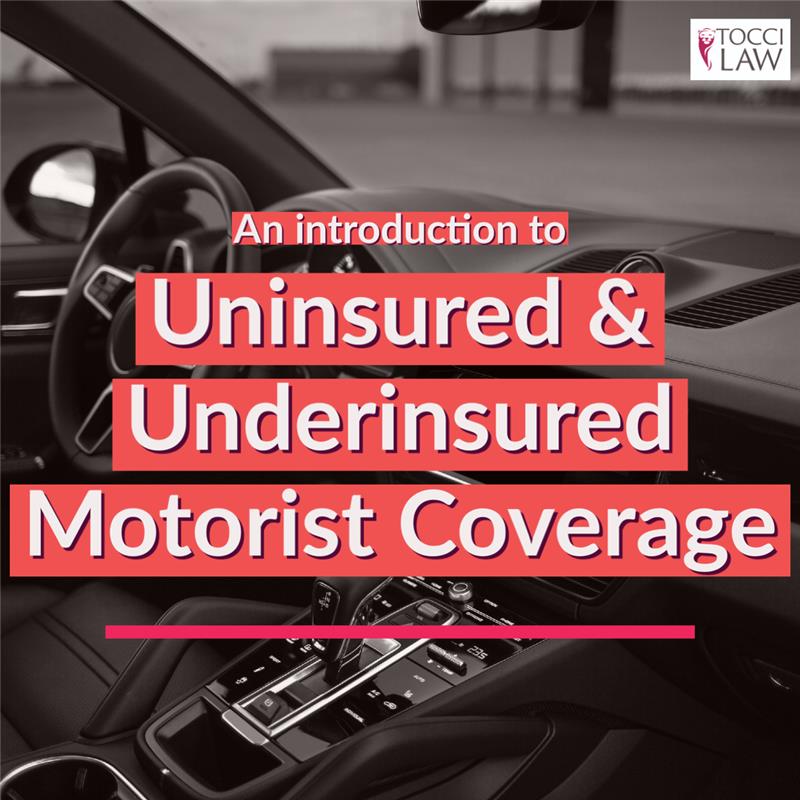Your auto insurance policy does more than provide you with coverage if you are sued for injuries you cause in an accident; it may also offer protection where you are injured by drivers that do not have insurance or do not have adequate insurance. This component of your auto insurance policy is called “Supplemental Uninsured/Underinsured Motorist” (often abbreviated as “SUM”) coverage.
What is SUM coverage?
SUM coverage is designed to protect you in the event you are involved in an accident with a motor vehicle that has no insurance (uninsured) or has insufficient coverage (underinsured). In either event, your auto insurance policy provides you with a certain monetary amount that may compensate for your injuries caused by others on the road. That amount depends on the auto insurance policies that cover you. In many instances, there may be multiple insurance policies that may come into play to provide coverage in a single accident. Although we cannot stack coverage (add together) the coverage from each policy, make a claim through each covering policy, to ensure that you have access to the maximum coverage available to compensate you for your injuries. If the other vehicles involved in the accident have coverage, those policies are primary to your SUM coverage. If you are in accident with a vehicle with no insurance or with less insurance than you carry, the SUM coverage comes into play. It bridges the gap between your SUM coverage limits and the coverage that should have been available if you were to submit a claim against an insured or adequately insured party.
What does SUM insurance typically cover?
Protection from uninsured drivers:
The most important aspect of SUM coverage is protection for injury claims caused by a driver operating a vehicle with no auto insurance. If there is no available liability insurance carried on the involved vehicle, you can submit a claim through your own policy.
Protection in hit and runs/unidentifiable drivers:
Your SUM coverage protects you in the event you are injured in an accident where the driver leaves the scene and/or you are unaware of the identity of the driver. In this case, your own policy will cover you for physical injuries sustained as a result. While it is wise to hire an attorney as soon as practical, if you are involved in a hit and run, there are conditions that must be met in a short time to be eligible to submit a SUM claim. Without satisfying those conditions, you may be barred from submitting a claim through your own insurance policy, even where the other driver does not have insurance. If you are in this situation, time is of the essence; call our office immediately for a free case evaluation.
Protection from underinsured drivers:
If the auto insurance liability limits carried by the owner and operator of the vehicle involved in the accident are less than your SUM coverage limits, your SUM coverage can make up the difference.
Protection from insolvent insurance companies:
In the event you are involved in an accident where the other driver/owner/vehicle was covered, but their insurance provider becomes insolvent, you can submit a claim through your SUM insurance.
Who can submit a SUM claim?
If you are the driver or occupant of a motor vehicle that was struck by a driver/owner with no insurance or inadequate insurance, you can submit a SUM claim through the policy of the vehicle you were occupying. You do not need to be named on the insurance policy to submit a claim. In addition to the SUM insurance of the vehicle you were in, your own SUM insurance may cover you for injuries, even if your vehicles were not involved. SUM insurance may extend to relatives who reside in your household and spouses.
Do motorcycles have SUM coverage?
Yes! Unlike No-Fault coverage (which covers you for your injuries), motorcycle accident injuries are not excluded from coverage. It is especially important that motorcycle drivers ensure that they have more than the minimum SUM coverage limits, as injuries by drivers and riders are more likely to experience extremely serious injuries from accidents.
How much SUM coverage is available?
The amount of SUM coverage available depends on several factors, such as whether you are a qualified person and how many vehicles are involved in the accident. The minimum SUM coverage that must be carried on vehicles operated in New York state is $25,000 per person and $50,000 per accident. The minimum amount of SUM coverage is automatically included when insuring a motor vehicle in New York State. However, you may purchase additional SUM coverage. Additional SUM coverage may be purchased in the amounts equal to or less than your liability coverage. You may submit a claim through your SUM insurance if the responsible parties have less coverage than your SUM coverage limits. If there are multiple vehicles involved, the liability limits from each vehicle must be less than the SUM coverage.
In New York, you may not stack SUM coverage on top of liability insurance. Thus, you may only collect the amount of the highest policy coverage. For example, if the vehicle involved in your accident carries the minimum New York State liability coverage of $25,000 per person, and you have $50,000 per person SUM limits, the maximum coverage available is $50,000 (not $75,000).
Are there time limits?
Yes. Whether the responsible parties have no insurance or carry inadequate amounts of insurance coverage, there are additional procedures and requirements that need to be met or benefits may be denied. The SUM insurance carrier must be on notice of intention to file a claim. Failure to timely provide notice of intention may result in the denial of SUM coverage. You must also receive written consent to settle a case against the responsible parties or SUM coverage can be denied.
Unlike the three (3) year statute of limitations you would have to file a lawsuit against the responsible driver/owner of the vehicle involved in the accident, you have six (6) years to start a SUM claim. However, you must first satisfy timely notice of intention requirements. It is best to reach out to us as soon as possible so that we can calculate all of the time limits and requirements associated with all insurance policies that may provide coverage in your case.
Call us to discuss your case:
The amount of insurance coverage available for injuries from a motor vehicle accident varies depending on several factors. It is important to consult with a personal injury attorney to learn which coverage is available to you in your specific case. There are subtle nuances in when coverage is available, how much is available, and to whom, which may be difficult to decipher. Speak with a skilled personal injury attorney about your unique situation to learn your individual rights and options. Our consultations are free. Call us to schedule an appointment (631) 343-7676.









